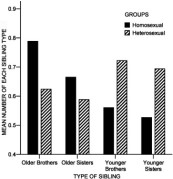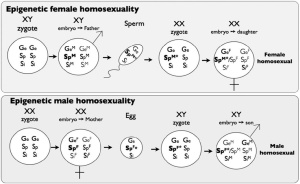The idea had always been that homosexuality was a criminal behavior, punishable by police and within the court of law. However, in the late 19th century, there was a shift away from this idea, and towards homosexuality as a medical concept. Medico-legal experts began writing literature concerned with determining whether certain people accused of criminal sexual behavior should be considered innocent because of mental illness or defect.
Today, the thought that homosexuality is a mental illness or defect is considered an insult. But back then, any form of homosexuality, even if you were simply suspected to be homosexual, you were punished with fines, imprisonment, and in some cases, death. To suggest that someone with homosexual tendencies was mentally ill and therefore should not be put to death was in essence, considered a saving grace.
 Karl Ulrichs, a German lawyer, wrote in a series of pamphlets from 1864 to 1879 that same sex love was a congenital, hereditary condition, not a matter of immorality. He argued that it was a form of psychosexual hermaphroditism. Outwardly, one would appear male, but inside – mentally, emotionally – he was female. He called himself an ‘Urning’ – a female soul in a male body. Because same sex love was congenital, it should not be criminally prosecuted.
Karl Ulrichs, a German lawyer, wrote in a series of pamphlets from 1864 to 1879 that same sex love was a congenital, hereditary condition, not a matter of immorality. He argued that it was a form of psychosexual hermaphroditism. Outwardly, one would appear male, but inside – mentally, emotionally – he was female. He called himself an ‘Urning’ – a female soul in a male body. Because same sex love was congenital, it should not be criminally prosecuted.
In 1869, Hungarian writer Karl Kertbeny coined the term ‘homosexual’. Prior to that, gay men were referred to as sodomites. He argued that homosexual attraction was innate, but did not believe all homosexuals were psychologically effeminate. Kertbeny argued against the sodomy laws of Prussian Paragraph 143 (which later became the infamous Paragraph 175), and argued for the ‘rights of man’. He initially presented the idea that homosexuality was inborn and unchangeable, and pointed out famous homosexuals that were great heroes in history.
referred to as sodomites. He argued that homosexual attraction was innate, but did not believe all homosexuals were psychologically effeminate. Kertbeny argued against the sodomy laws of Prussian Paragraph 143 (which later became the infamous Paragraph 175), and argued for the ‘rights of man’. He initially presented the idea that homosexuality was inborn and unchangeable, and pointed out famous homosexuals that were great heroes in history.
In 1870, Karl Westphal published an article, using ‘contrary sexual feeling’ to describe the same-sex attraction of an effeminate male and a masculine female. Westphal claimed the sexual sensation was congenital, and it should come under psychiatric care rather than legal prosecution. His terminology of ‘contrary sexual feeling’ would be translated into many different languages. In Italy, Arrigo Tamassia took the diagnosis and translated it into ‘inversion of the sexual instinct’. French neurologist Jean Martin Charcot later translated it into ‘inversion of the genital sense.’
In Charcot’s work, he labeled homosexuality as a sexual perversion, relying on the theory of hereditary degeneration. He argued that sexual inversion was a neuropsychiatric degenerative condition like hysteria and epilepsy. Charcot believed it was a serious mental illness likely to be associated with other disorders.
The term ‘sexual inversion’ dominated medical texts in terms of a medical definition. Extensive research into a biological basis for homosexuality led to hypotheses that homosexuals were neuro-endocrinological hermaphrodites. Basically, a male had the physical anatomy of a male, but hormonally and mentally, he exhibited feminine qualities.
Richard von Krafft-Ebing was a German physicist, who wrote Psychopathia Sexualis in 1886. In it, he presented  homosexuality as a severe manifestation of hereditary degeneration. Krafft-Ebing thought procreation was the only purpose of sexual desire, and that any other form of it was a perversion. He defined four categories of “cerebral neuroses”
homosexuality as a severe manifestation of hereditary degeneration. Krafft-Ebing thought procreation was the only purpose of sexual desire, and that any other form of it was a perversion. He defined four categories of “cerebral neuroses”
- Paradoxia – sexual desire at the wrong time of life
- Anesthesia – insufficient sexual desire
- Hyperesthesia – excessive sexual desire
- Paraesthesia – misdirected sexual desire (homosexuality, bisexuality, fetishism, sadism, masochism, and pedophilia)
The final cerebral neuroses, paraesthesia, has led to the grouping of homosexuality with pedophilia and bestiality in arguments against things like legalization of same-sex marriage. It seems it’s a stigma we’ve yet to fully overcome.
However, Krafft-Ebing later argued that homosexuals could be perfectly respectable and functional individuals. This was after meeting a number of homosexuals throughout his life. He also began to argue against sodomy laws and testified in defense of homosexuals.
In the late 1800’s, German physician Magnus Hirschfeld spoke out about his homosexuality, arguing it as an intermediate sex and a natural, biological variant. He founded the Scientific Humanitarian Committee in 1897, and also founded the Institute for Sexual Science, which was closed down by the Nazis in 1933. Hirschfeld also argued that failed attempts to ‘convert’ through psychoanalysis proved that homosexuality is physiologically innate, and not a mental condition.
Endocrinologist Eugen Steinach did extensive research with altering the sexual characteristics of rats through castration or testes implants. He was one of the first to attempt to surgically ‘correct’ homosexuality by implanting ‘normal’ testes. His results were inconclusive.
The inversion hypothesis still existed in the 1930’s. Psychiatrist George Henry studied the anatomy of homosexuals, to document the sex-atypicality of their genitals and secondary sex characteristics (the Adam’s apple, facial hair, breast size, etc.). At the time, the brains and nervous systems of homosexuals were assumed to have some cross-gendered traits – different sized parts of the brain, glandular differences, etc. This idea progressed through the end of the 20th century, when neuroanatomical research on sexual orientation still relied on the inversion hypothesis. An article by British American neuroscientist Simon LeVay argued that an area of the homosexual man’s hypothalamus was closer in size to that of women than of heterosexual men.
Sigmund Freud wrote of four possible sexual theories on the origins of homosexuality
- Homosexuality arises as an outcome of the Oedipus conflict and the boy’s discovery that his mother is castrated. This creates an intense castration anxiety that causes the boy to turn from his castrated mother to a “woman with a penis” – an effeminate male
- In the Three Essays, Freud developed the theory that the homosexual child is so over-attached to his mother that he identifies with her and narcissistically seeks love objects like himself so he can love them like his mother loved him
- If a ‘negative’ or ‘inverted’ Oedipus complex occurs, a boy seeks his father’s love and masculine identification by taking on a feminine identification, and reverts to anal eroticism
- Finally, homosexuality could result from reaction formation – sadistic jealousy of brothers and father is safely converted into love of other men
Freud believed that homosexuality (or ‘inversion’ as it was called) could be a natural outcome of normal development in some people. He believed in a ‘constitutional bisexuality’: in every individual, there was a certain balance of masculine and feminine tendencies. Life experiences, particularly traumatic ones, allowed for the development of certain tendencies, and in turn, brought about their expression. Because of this, homosexuality was not a mental illness, but an unconflicted expression of an innate instinct.
He did not believe in treating homosexuality, as it was not a mental illness. In 1935, he received a letter from a woman that wanted Freud to ‘cure’ her ‘inverted’ son. His response, which was later published, contained:
“Homosexuality is assuredly no advantage, but it is nothing to be ashamed of, no vice, no degradation, it cannot be classified as an illness; we consider it to be a variation of the sexual function produced by a certain arrest of sexual development. Many highly respectable individuals of ancient and modern times have been homosexuals, several of the greatest men among them (Plato, Michelangelo, Leonardo da Vinci, etc.). It is a great injustice to persecute homosexuality as a crime, and cruelty too….
“If [your son] is unhappy, neurotic, torn by conflicts, inhibited in his social life, analysis may bring him harmony, peace of mind, full efficiency whether he remains a homosexual or gets changed….”
 However, analyst Sandor Rado had other thoughts. He viewed homosexuality as a sign of development gone awry. He argued against Freud’s hypotheses, stating that the 19th century belief in embryonic hermaphroditism (the idea that every embryo had the potential to become a man or a woman) was what Freud based his constitutional bisexuality on. Since this hypothesis was disproven, Rado argued that heterosexuality was the only non-pathological outcome of human sexual development.
However, analyst Sandor Rado had other thoughts. He viewed homosexuality as a sign of development gone awry. He argued against Freud’s hypotheses, stating that the 19th century belief in embryonic hermaphroditism (the idea that every embryo had the potential to become a man or a woman) was what Freud based his constitutional bisexuality on. Since this hypothesis was disproven, Rado argued that heterosexuality was the only non-pathological outcome of human sexual development.
Rado’s views caused a shift in belief to his theory of pathology. Because of this, some analysts began to claim they could ‘cure’ homosexuality. These ‘cures’ consisted of psychoanalysis to get at the root for the same-sex attraction and attempted to change the homosexual’s image of his or her attraction. Physical ‘treatments’ did occur as well, and included bladder washing, rectal massage, castration, and hypnosis.
In 1952, the first edition of the American Psychiatric Association’s Diagnostic and Statistical Manual of Mental Disorders (DMS-I) classified homosexuality as a mental disorder. It was removed as a mental disorder in 1973.
(DMS-I) classified homosexuality as a mental disorder. It was removed as a mental disorder in 1973.
After this stigma was removed, there was a shift in thought from homosexuality as a pathology toward viewing it as a normal variant of human sexuality. However, the argument that homosexuality is a mental disorder is still used. Reparative therapy, like reestablishing gender roles, and groups like NARTH (National Research & Therapy of Homosexuality) claim they can ‘take the gay away’. Some claim these groups have helped them, others claim they simply try to suppress homosexual attraction through demeaning and belittling the homosexual.
As you can see, psychology has both helped and hurt the cause for equality. Establishing a psychological element to ‘what causes homosexuality’ has also led to a look at the genetic makeup of sexuality. And this is what the next post will take a look at – the possibility of a ‘gay gene’ and the physical make of a homosexual
 Sappho was a Greek Lyric Poet, born on the island of Lesbos. Her birth was between 630 and 612 BCE, and she died
Sappho was a Greek Lyric Poet, born on the island of Lesbos. Her birth was between 630 and 612 BCE, and she died  sometime around 570 BCE, making her around 60 years of age when she passed.
sometime around 570 BCE, making her around 60 years of age when she passed. Not much is known or documented about her, and the bulk of Sappho’s poetry has been lost. The only source for her history is through what little remains of her work, which is referred to as ‘Fragments’.
Not much is known or documented about her, and the bulk of Sappho’s poetry has been lost. The only source for her history is through what little remains of her work, which is referred to as ‘Fragments’. honey-smiling Sappho” and it has been written that her relationships among her female friends were of a homosexual nature. 3rd century philosopher Maximus of Tyre wrote:
honey-smiling Sappho” and it has been written that her relationships among her female friends were of a homosexual nature. 3rd century philosopher Maximus of Tyre wrote: Many famous poets used the Sapphic meter in there writing, including Rudyard Kipling, in a tribute to William Shakespeare, called “The Craftsman”. The first verse is as follows:
Many famous poets used the Sapphic meter in there writing, including Rudyard Kipling, in a tribute to William Shakespeare, called “The Craftsman”. The first verse is as follows:
































